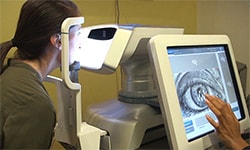Editorially Independent Content
Ocular surface disease and meibomian gland dysfunction are ubiquitous in eye care. If we look for it, we find it. The challenge is helping patients understand how their ocular surface affects their eyes, particularly in asymptomatic patients. Osmolarity testing with the TearLab Osmolarity System (TearLab Corporation) is a helpful test to diagnose ocular surface disease and educate patients about how their tear film is changing over time.
How it Works
TearLab Osmolarity System measures the osmolarity of tears using nanoliter (nL) volumes of tear fluid collected directly from the eyelid margin. The test must be performed in each eye before any drops are instilled because artificial tears, stains, or topical medications may cause false readings. In our practice the technicians perform tear osmolarity. While the process itself is fairly simple, as ophthalmologists, we must educate and empower our technicians to ask the appropriate questions to know when to perform tear osmolarity so testing is not deferred to a subsequent office visit.
The system consists of two battery-operated osmolarity test pens, the countertop unit, and a supply of single-use test cards. The countertop unit analyzes the tear fluid samples and displays the results on an LCD screen. The test cards come in individual foil pouches and one is loaded onto each test pen.
The patient is asked to look up and out and approached from the lateral angle. The test card is gently placed on the tear lake in the corner of the eye on the inner lower lid margin. An auditory beep and green light will confirm that the sample is collected and the test pen should be returned to the countertop unit within 40 seconds. The unit analyzes the samples and displays results within seconds.
For any instrument to provide accurate numbers, certain steps must be followed. With the TearLab Osmolarity System, two calibrations must be performed. One is the monthly calibration, which checks high and low control solutions to confirm that the device is functioning properly and storage conditions of test cards are suitable. The other is a daily calibration that must be done by the technicians when they open the exams rooms using blue reusable electronic check cards. A log of calibration tests must be maintained for each unit.
The TearLab Osmolarity System is a CLIA-waived test system, which means each testing site must have a CLIA Certificate of Waiver. Additionally, the test logs are subject to audit by inspectors so it is imperative to maintain complete records for each unit.
Interpreting Results
The TearLab provides a numeric osmolarity value (mOsm/L). The normal range is 300 and below. The higher the number over 300 is an indicator to the severity of ocular surface disease. We also look for a disparity of numbers between eyes. A difference greater than 8 mOsm/L also represents tear film instability with subsequent ocular surface disease.
On return visits tear osmolarity is important to monitor to determine if the treatment regimen is adequate. If one sees a trend of the numbers going down toward 300, then the treatment regimen is working. If the numbers have increased, then either the patient is not following the prescribed regimen or the disease is still progressing and a more aggressive treatment is necessary. Having a concrete objective number helps diagnose and monitor the treatment of ocular surface disease and meibomian gland dysfunction.
Patient Education
It is very important to review results with patients. Patients are used to getting numbers in the medical field and appreciate being able to follow their trends. As a helpful tool, TearLab provides handouts to give to patients to keep as a record of their results. The objective number helps patients understand that they do indeed have ocular surface disease and therefore should follow the prescribed treatments.





